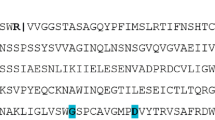Abstract
Numerous proteases and protease inhibitors are expressed in the lobster olfactory organ. One of these proteases, olfactory enriched transcript 03 (OET-03), is particularly interesting because its mRNA is expressed only in one cell type of the olfactory organ of the American lobster, Homarus americanus. We have obtained a full-length cDNA clone of OET-03. The predicted amino acid sequence is equally divided between a novel N-terminal domain and a conserved serine protease catalytic domain at the C-terminus. Heterologous expression in HEK293 cells allowed protease assays demonstrating that OET-03 cleaved a specific serine protease substrate, N-alpha benzoyl-L-arginine p-nitroanilide, but did not cleave a substrate of metalloproteases and cysteine proteases. OET-03 protease activity was significantly inhibited by the chymotrypsin-like protease inhibitor, tosyl-L-phenylalanine chloromethyl ketone, but not by the general protease inhibitor, phenylmethylsulfonyl fluoride. Immunoreactivity for OET-03 was detected only in the cells previously shown to contain OET-03 mRNA. The cytoplasm of these cells was filled with enlarged smooth endoplasmic reticulum (a characteristic of secretory cells) that appeared to expand into large electron-translucent areas at the ventral end of the cell. The ventral ends of these secretory cells were apposed to phalloidin-labeled triangular structures reminiscent of the beginnings of the ducts of crustacean tegumental glands. This putative gland was found only in association with the aesthetasc sensory units of the olfactory organ, hence the name, aesthetasc tegumental gland.






Similar content being viewed by others
References
Ache BW, Zhainazarov A (1995) Dual second-messenger pathways in olfactory transduction. Curr Opin Neurobiol 5:461–466
Ache BW, Fuzessery ZM, Carr WES (1976) Antennular chemoreception in the spiny lobster, Panulirus argus: comparative tests of high and low molecular weight stimulants. Biol Bull 151:273–282
Ache BW, Munger S, Zhainazarov A (1998) Organizational complexity in lobster olfactory receptor cells. Ann N Y Acad Sci 855:194–198
Alexander CG (1989) Tegumental glands in the paragnaths of the Palaemon serratus (Crustacea: Natantia). J Mar Biol Assoc UK 69:53–63
Altschul SF, Madden TL, Schaffer AA, Zhang J, Zhang Z, Miller W, Lipman DJ (1997) Gapped BLAST and PSI-BLAST: a new generation of protein database search programs. Nucleic Acids Res 25:3389–3402
Armstrong PB, Quigley JP (1999) Alpha2-macroglobulin: an evolutionarily conserved arm of the innate immune system. Dev Comp Immunol 23:375–390
Babu DE, Rao KH, Shyamasundari K, Devi DVU (1985) Histochemistry of the cuticle of the crab Menippe rumphii (Fabricius) (Crustacea: Brachyura) in relation to moulting. J Exp Mar Biol Ecol 88:129–144
Barrett AJ (1994) Classification of peptidases. Methods Enzymol 244:1–15
Benjamin DC, Kristjansdottir S, Gudmundsdottir A (2001) Increasing the thermal stability of euphauserase A cold-active and multifunctional serine protease from Antarctic krill. Eur J Biochem 268:127–131
Berg CH, Kalfas S, Malmsten M, Arnebrant T (2001) Proteolytic degradation of oral biofilms in vitro and in vivo: potential of proteases originating from Euphausia superba for plaque control. Eur J Oral Sci 109:316–324
Bobkov YV, Ache BW (2005) Pharmacological properties and functional role of a TRP-related ion channel in lobster olfactory receptor neurons. J Neurophysiol 93:1372–1380
Carr WE, Gleeson RA, Trapido-Rosenthal HG (1990) The role of perireceptor events in chemosensory processes. Trends Neurosci 13:212–215
Cerenius L, Söderhäll K (2004) The prophenoloxidase-activating system in invertebrates. Immunol Rev 198:116–126
Cooper EL, Kauschke E, Cossarizza A (2002) Digging for innate immunity since Darwin and Metchnikoff. Bioessays 24:319–333
Derby CD (1984) Molecular weight fractions of natural foods that stimulate feeding in crustaceans, with data from the lobster Homarus americanus. Mar Behav Physiol 10:273–282
Derby CD, Schmidt M (2005) Exocrine glands containing serine protease are associated with olfactory sensilla in the Spiny lobster, Panulirus argus. Chem Senses (in press)
Derby CD, Cate HS, Gentilcore LR (1997) Perireception in olfaction: molecular mass sieving by aesthetasc sensillar cuticle determines odorant access to receptor sites in the Caribbean spiny lobster Panulirus argus. J Exp Biol 200:2073–2081
Gimelbrant AA, Stoss TD, Landers TM, McClintock TS (1999) Truncation releases olfactory receptors from the endoplasmic reticulum of heterologous cells. J Neurochem 72:2301–2311
Gimelbrant AA, Haley SL, McClintock TS (2001) Olfactory receptor trafficking involves conserved regulatory steps. J Biol Chem 276:7285–7290
Gleeson RA, McDowell LM, Aldrich HC, Trapido-Rosenthal HG, Carr WE (1991) Localization of 5′-ectonuclease/phosphatase activity within the olfactory sensilla of the spiny lobster, Panulirus argus. Cell Tissue Res 265:385–391
Gleeson RA, Trapido-Rosenthal HG, McDowell LM, Aldrich HC, Carr WE (1992) Ecto-ATPase/phosphatase activity in the olfactory sensilla of the spiny lobster, Panulirus argus: localization and characterization. Cell Tissue Res 269:439–445
Grünert U, Ache BW (1988) Ultrastructure of the aesthetasc (olfactory) sensilla of the spiny lobster, Panulirus argus. Cell Tissue Res 251:95–103
Hollins B, Hardin D, Gimelbrant AA, McClintock TS (2003) Olfactory-enriched transcripts are cell-specific markers in the lobster olfactory organ. J Comp Neurol 455:125–138
Ikeda H, Hirano Y, Saigusa M (2004) A pair of rosette glands in the embryo and zoeal larva of an estuarine crab Sesarma haematocheir, and classification of the tegumental glands in the embryos of other crabs. J Morphol 259:55–68
Johns ME, Tai PC, Derby CD (2004) Serine proteases in the spiny lobster olfactory organ: their functional expression along a developmental axis, and the contribution of a CUB-serine protease. J Neurobiol 61:377–391
Johnson B, Talbot P (1987) Ultrastructural analysis of the pleopod tegumental glands in male and female lobsters, Homarus americanus. J Crustac Biol 7:288–301
Klein B, Sellos D, Van Wormhoudt A (1998) Genomic organisation and polymorphism of a crustacean trypsin multi-gene family. Gene 216:123–129
Krem MM, Di Cera E (2001) Molecular markers of serine protease evolution. EMBO J 20:3036–3045
Krem MM, Rose T, Di Cera E (2000) Sequence determinants of function and evolution in serine proteases. Trends Cardiovasc Med 10:171–176
Lee SY, Soderhall K (2002) Early events in crustacean innate immunity. Fish Shellfish Immunol 12:421–437
Letunic I, Copley RR, Schmidt S, Ciccarelli FD, Doerks T, Schultz J, Ponting CP, Bork P (2004) SMART 40: towards genomic data integration. Nucleic Acids Res 32 (Database issue):D142–D144
Levine MZ, Harrison PJ, Walthall WW, Tai PC, Derby CD (2001) A CUB-serine protease in the olfactory organ of the spiny lobster Panulirus argus. J Neurobiol 49:277–302
Levy F, Rabel D, Charlet M, Bulet P, Hoffmann JA, Ehret-Sabatier L (2004) Peptidomic and proteomic analyses of the systemic immune response of Drosophila. Biochimie 86:607–616
Mankad RV, Gimelbrant AA, McClintock TS (1998) Consensus translational initiation sites of marine invertebrate phyla. Biol Bull 195:252–254
Marchler-Bauer A, Anderson JB, Cherukuri PF, DeWeese-Scott C, Geer LY, Gwadz M, He S, Hurwitz DI, Jackson JD, Ke Z, et al (2005) CDD: a conserved domain database for protein classification. Nucleic Acids Res 33 (Database Issue):D192–D196
Mauchline J (1977) The integumental sensilla and glands of pelagic crustacea. J Mar Biol Assoc UK 57:973–994
McClintock TS, Byrnes AP, Lerner MR (1992) Molecular cloning of a G protein alpha(i) subunit from the lobster olfactory organ. Mol Brain Res 14:273–276
Monard D (1988) Cell-derived proteases and protease inhibitors as regulators of neurite outgrowth. Trends Neurosci 11:541–544
Rawlings ND, Barrett AJ (1994) Families of serine peptidases. Methods Enzymol 244:19–61
Rittschof D (1990) Peptide-mediated behaviours in marine organisms: evidence for a common theme. J Chem Ecol 16:261–272
Rittschof D (1993) Body odors and neutral-basic peptide mimics: a review of responses by marine organisms. Am Zool 33:487–493
Rybczynski R, Vogt RG, Lerner MR (1990) Antennal-specific pheromone-degrading aldehyde oxidases from the moths Antheraea polyphemus and Bombyx mori. J Biol Chem 265:19712–19715
Scarisbrick IA, Isackson PJ, Ciric B, Windebank AJ, Rodriguez M (2001) MSP, a trypsin-like serine protease, is abundantly expressed in the human nervous system. J Comp Neurol 431:347–361
Schmidt M, Ache BW (1994) Descending neurons with dopamine-like or with substance P/FMRFamide-like immunoreactivity target the somata of olfactory interneurons in the brain of the spiny lobster, Panulirus argus. Cell Tissue Res 278:337–352
Schmitt BC, Ache BW (1979) Olfaction: responses of a decapod crustacean are enhanced by flicking. Science 205:204–206
Shyamasundari K, Rao KH (1978) Studies on the Indian sand lobster Thenus orientalis (Lund): mucopolysaccharides of the tegumental glands. Folia Histochem Cytochemica 16:247–254
Steullet P, Cate HS, Derby CD (2000) A spatiotemporal wave of turnover and functional maturation of olfactory receptor neurons in the spiny lobster Panulirus argus. J Neurosci 20:3282–3294
Stevenson JR (1961) Polyphenol oxidase in the tegumental glands in relation to the molting cycle of the isopod crustacean Armadillidium vulgare. Biol Bull 121:554–559
Stevenson JR (1985) Dynamics of the integument. In: Bliss DE, Mantel LH (eds) The biology of crustacea, vol 9. Academic, Orlando, pp 1–42
Stoss TD, Nickell MD, Hardin D, Derby CD, McClintock TS (2004) Inducible transcript expressed by reactive epithelial cells at sites of olfactory sensory neuron proliferation. J Neurobiol 58:355–368
Sumi Y, Dent MA, Owen DE, Seeley PJ, Morris RJ (1992) The expression of tissue and urokinase-type plasminogen activators in neural development suggests different modes of proteolytic involvement in neuronal growth. Development 116:625–637
Talbot P, Demers D (1993) Tegumental glands of Crustacea. In: Horst NH, Freeman JA (eds) The crustacean integument morphology and biochemistry. CRC, Ann Arbor, pp 152–191
Talbot P, Al-Haji H, Demers D, Howard D (1991) Distribution of microfilaments and microtubules in Homarus pleopod tegumental gland (Crustacea, Decapoda). Zoomorphology 110:329–338
Vogt RG, Riddiford LM, Prestwich GD (1985) Kinetic properties of a sex pheromone-degrading enzyme: the sensillar esterase of Antheraea polyphemus. Proc Natl Acad Sci U S A 82:8827–8831
Xu F, Bose SC, McClintock TS (1999) Lobster G-protein coupled receptor kinase that associates with membranes and G(beta) in response to odorants and neurotransmitters. J Comp Neurol 415:449–459
Yonge CM (1932) On the nature and permeability of chitin. I. The chitin lining the foregut of decapod Crustacea and the function of the tegumental glands. Proc R Soc Lond [Biol] 111:298–329
Zanotto FP, Wheatly MG (2002) Calcium balance in crustaceans: nutritional aspects of physiological regulation. Comp Biochem Physiol A Mol Integr Physiol 133:645–660
Zeni C, Stagni A (2000) Ducts of the labral glands of Leptestheria dahalacensis (Crustacea: Branchiopoda: Spinicaudata). J Morphol 246:68–84
Zou E, Fingerman M (1999) Effects of estrogenic agents on chitobiase activity in the epidermis and hepatopancreas of the fiddler crab, Uca pugilator. Ecotoxicol Environ Saf 42:185–190
Acknowledgements
We thank Dr. Bruce Maley, Dr. Charles Derby and Dr. Manfred Schmidt for helpful discussions.
Author information
Authors and Affiliations
Corresponding author
Additional information
This work was supported by National Institutes of Health Research grant no. R01 DC002366.
Rights and permissions
About this article
Cite this article
Stepanyan, R., Haley, S.B. & McClintock, T.S. Olfactory specific chymotrypsin-like serine protease from the aesthetasc tegumental gland of the lobster, Homarus americanus . Cell Tissue Res 322, 321–330 (2005). https://doi.org/10.1007/s00441-005-0022-2
Received:
Accepted:
Published:
Issue Date:
DOI: https://doi.org/10.1007/s00441-005-0022-2




